In the printed but unpublished Collection before mentioned, page 396, nearly three hundred quarto pages are devoted to descriptions of signs arranged in alphabetic order. A few of these are now presented to show the method adopted. They have been selected either as having connection with the foregoing discussion of the subject or because for some of them pictorial illustrations had already been prepared. There is propriety in giving all the signs under some of the title words when descriptions of only one or two of those signs have been used in the foregoing remarks. This prevents an erroneous inference that the signs so mentioned are the only or the common or the generally prevailing signs for the idea conveyed. This course has involved some slight repetition both of descriptions and of illustrations, as it seemed desirable that they should appear to the eye in the several connections indicated. The extracts are rendered less interesting and instructive by the necessity for omitting cross-references which would show contrasts and similarities for comparison, but would require a much larger part of the collected material to be now printed than is consistent with the present plan. Instead of occupying in this manner the remaining space allotted to this paper, it was decided to present, as of more general interest, the descriptions of Tribal Signs, Proper Names, Phrases, Dialogues, Narratives, Discourses, and Signals, which follow the Extracts.
It will be observed that in the following extracts there has been an attempt to supply the conceptions or origin of the several signs. When the supposed conception, obtained through collaborators, is printed before the authority given as reference, it is understood to have been gathered from an Indian as being his own conception, and is therefore of special value. When printed after the authority and within quotation marks it is in the words of the collaborator as offered by himself. When printed after the authority and without quotation marks it is suggested by this writer.
The letters of the alphabet within parentheses, used in some of the descriptions, refer to the corresponding figures in Types of Hand Positions at the end of this paper. When such letters are followed by Arabic numerals it is meant that there is some deviation, which is described in the text, from that type of hand position corresponding with the letter which is still used as the basis of description. Example: In the first description from (Sahaptin I) for bad, mean, page 412, (G) refers to the type of hand position so marked, being identically that position, but in the following reference, to (R 1), the type referred to by the letter R has the palm to the front instead of backward, being in all other respects the position which it is desired to illustrate; (R), therefore, taken in connection with the description, indicates that change, and that alone. This mode of reference is farther explained in the Examples at the end of this paper.
References to another title word as explaining a part of a description or to supply any other portions of a compound sign will always be understood as being made to the description by the same authority of the sign under the other title-word. Example: In the second description by (Sahaptin I) for bad, mean, above mentioned, the reference to Good is to that sign for good which is contributed by Rev. G.L. Deffenbaugh, and is referred to as (Sahaptin I.).
Antelope
Pass the open right hand outward from the small of the back. (Wied.) This, as explained by Indians lately examined, indicates the lighter coloration upon the animal’s flanks. A Ute who could speak Spanish accompanied it with the word blanco, as if recognizing that it required explanation.
With the index only extended, hold the hand eighteen or twenty inches transversely in front of the head, index pointing to the left, then rub the sides of the body with the flat hands. (Cheyenne IV; Dakota VI.) “The latter sign refers to the white sides of the animal; the former could not be explained.”
Extend and separate the forefingers and thumbs, nearly close all the other fingers, and place the hands with backs outward above and a little in front of the ears, about four inches from the head, and shake them back and forth several times. Antelope’s horns. This is an Arapaho sign. (Dakota I, II, IV.)

Close the right hand, leaving the end of the index in the form of a hook, and the thumb extended as in Fig. 234; then wave the hand quickly back and forth a short distance, opposite the temple. (Hidatsa I; Arikara I.) “Represents the pronged horn of the animal. This is the sign ordinarily used, but it was noticed that in conversing with one of the Dakotas the sign of the latter (Dakota VI) was used several times, to be more readily understood.”
Place both hands, fingers fully extended and spread, close to the sides of the head. Wied’s sign was readily understood as signifying the white flanks. (Apache I.)
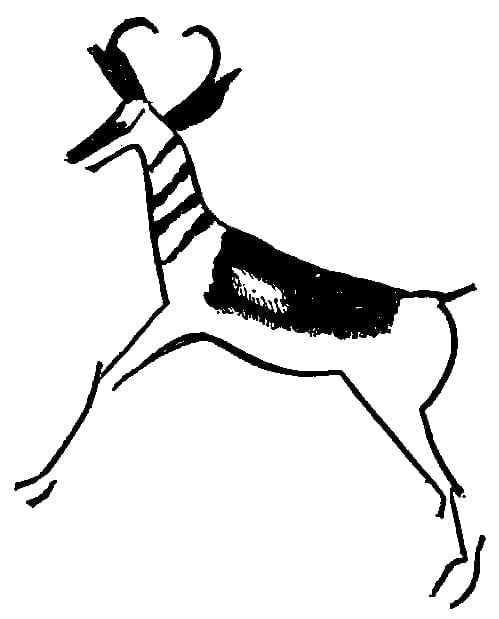
In connection with the above signs Fig. 235 is presented, which was drawn by Running Antelope, an Uncpapa Dakota, as his personal totem, or proper name.
Bad, Mean
Make the sign for Good and then that of Not. (Long.)
Close the hand, and open it whilst passing it downward. (Wied.) This is the same as my description; but differently worded, possibly notes a less forcible form. I say, however, that the arm is “extended.” The precise direction in which the hand is moved is not, I think, essential. (Matthews.) This sign is invariably accompanied by a countenance expressive of contempt. (F. Jacker.).
Scatter the dexter fingers outward, as if spurting away water from them. (Burton.)
(1) Right hand partially elevated, fingers closed, thumb clasping the tips; (2) sudden motion downward and outward accompanied by equally sudden opening of fingers and snapping of the fingers from the thumb. (Cheyenne II.)
Right hand closed back to front is moved forcibly downward and forward, the fingers being violently opened at instant of stopping the motion of hand. (Cheyenne IV.)
Right hand closed (B) carried forward in front of the body toward the right and downward, during which the hand is opened, fingers downward, as if dropping out the contents. (Dakota I.) “Not worth keeping.”
Half close the fingers of the right hand, hook the thumb over the fore and middle fingers; move the hand, back upward, a foot or so toward the object referred to, and suddenly let the fingers fly open. Scattered around, therefore bad. An Arapaho sign. (Dakota IV.)
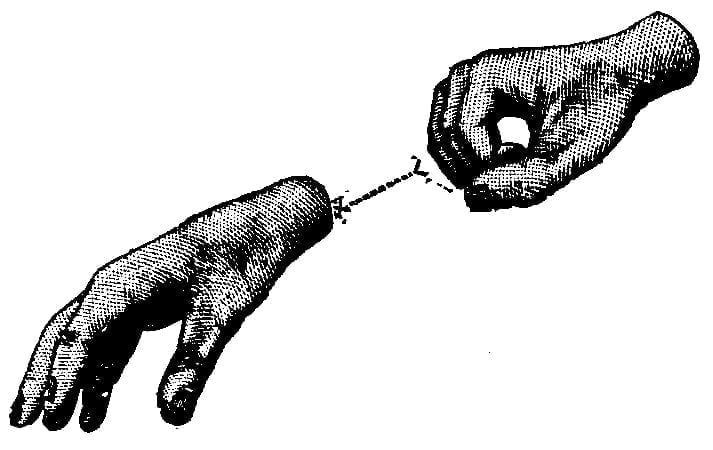
Close the fingers of the right hand, resting the tips against the thumb, then throw the hand downward and outward toward the right to arm’s length, and spring open the fingers. Fig. 236. (Dakota VI, VII, VIII; Ponka II; Pani I.)
The sign most commonly used for this idea is made by the hand being closed near the breast, with the back toward the breast, then as the arm is suddenly extended the hand is opened and the fingers separated from each other. (Mandan and Hidatsa I.)
Hands open, palms turned in; move one hand toward, and the other from, the body; then vice versâ. (Omaha I.)
Throw the clinched right hand forward, downward, and outward, and when near at arm’s length, suddenly snap the fingers from the thumb as if sprinkling water. (Wyandot I.) “To throw away contemptuously; not worth keeping.”
Raise hand in front of breast, fingers hooked, thumb resting against second finger, palm downward (G), then with a nervous movement throw the hand downward to the right and a little behind the body, with an expression of disgust on the face. During motion of hand the fingers are suddenly extended as though throwing something out of the hand, and in final position the fingers and thumb are straight and separated, palm backward (R 1). (Sahaptin I.) “Away with it!”
Another: Same motion of arm and hand as in good. But in the first position fingers are closed, and as the hand moves to the right they are thrown open, until in final position all are extended as in final for good. (Sahaptin I.)
Extend the right hand, palm downward, and move it in a horizontal line from the body, then suddenly turn the hand over as if throwing water from the back of it or the index. (Comanche I.) “Good, no.”
Pass the flat right hand, interruptedly, downward and backward past the right side. (Pima and Papago I.) “Putting aside.”
Deaf-mute natural signs:
Hold forward the closed hand with the little finger up, at the same time nodding the head. (Ballard.)
Draw the tongue out a little and then shake the head with a displeased look. (Larson.)
Use the sign for handsome (see first part of the sign for Good), at the same time shake the head as if to say “no.” (Ziegler.)
Deaf-mute signs:
The hand closed (except the little finger which is extended and raised), and held forward with the fingers to the front is the sign for bad illustrated in the Report for 1879 of the Ohio Institution for the Deaf and Dumb. This sign is used among the deaf-mutes in England.
Bear, animal
Pass the hand before the face to mean ugliness, at the same time grinning and extending the fingers like claws. (Burton.)
Hands in front of and about eight inches above the elbows, fingers slightly bent and open, thumbs and palms to the front to represent claws,or bear in standing position. Sometimes accompanied by clawing motion. (Creel.)
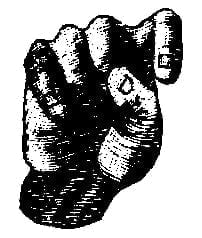
(1) Middle and third finger of right hand clasped down by the thumb, forefinger and little finger extended, crooked downward; (2) the motion of scratching made in the air. (Cheyenne II.) Fig. 237.
Fingers of both hands closed, except the thumb and little finger, which are extended, and point straight toward the front, hands horizontal, backs upward, are held in front of their respective sides near the body, and then moved directly forward with, short, sharp jerking motions. (Dakota I.) “From the motion of the bear in running.” This is also reported as an Arapaho sign. (Dakota IV.) The paws and claws are represented.
Seize a short piece of wood, say about two feet long, wave in the right hand, and strike a blow at an imaginary person. (Omaha I.)
Another: Seize a short thing about six inches long, hold it as dagger, pretend to thrust it downward under the breast-bone repeatedly, and each time farther, grunting or gasping in doing so; withdraw the stick, holding it up, and, showing the blood, point to the breast with the left forefinger, meaning to say so do thou when you meet the bear. (Omaha I.)
Another: Pretend to stab yourself with an arrow in various parts of the body, then point towards the body with the left-hand forefinger. (Omaha I.)
Arms are flexed and hands clasped about center of breast; then slowly fall with arms pendulous and both hands in type-position (Q). The sign is completed by slowly lifting the hands and arms several times in imitation of the animal’s locomotion. Movement and appearance of animal’s front feet. (Oto I.)
Hold the closed right hand at the height of the elbow before the right side, palm downward, extend and curve the thumb and little finger so that their tips are nearly directed toward one another before the knuckles of the closed fingers; then push the hand forward several times. (Kaiowa I; Comanche III; Apache II; Wichita II.) “Paw and long claws.” Fig. 238.
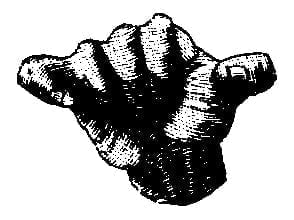
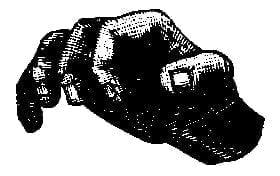
Hold both closed hands before the body, palms down, and about eight inches apart; reach forward a short distance, relaxing the fingers as if grasping something with them, and draw them back again as the hands are withdrawn to their former position. Ordinarily but one hand is used, as in Fig. 239. (Ute I.) “Scratching, and grasping with the claws.”
The right hand thrown in the position as for horse, as follows: Elevate the right-hand, extended, with fingers joined, outer edge toward the ground, in front of the body or right shoulder, and pointing forward, resting the curved thumb against the palmar side of the index, then extend both hands with fingers extended and curved, separated, palms down, and push them forward several times, making a short arch. (Apache I.) “The animal that scratches with long claws.”

Fig. 240 is from a Moqui rock etching, contributed by Mr. G. K. Gilbert, showing the pictorial mode of representing the animal.
Deaf-mute sign:
Claw both shoulders with the fingers. (Wing.)
- – Grizzly.
Right hand flat and extended, held at height of shoulder, palm forward, then bring the palm to the mouth, lick it with the tongue, and return it to first position. (Omaha I.) “Showing blood on the paw.”
Other remarks upon the signs for bear are made on pages 293 and 345.
Brave
Close the fists, place the left near the breast, and move the right over the left toward the left side. (Wied.) A motion something like this, which I do not now distinctly recalla short of wrenching motion with the fists in front of the chestI have seen used for strong. If Wied‘s sign-maker’s hand first struck the region over the heart (as he may have done) he would then have indicated a “strong heart,” which is the equivalent for brave. (Matthews.) This sign is used by the Sioux at the present day to denote small. (McChesney.) I have seen a similar sign repeatedly, the only variation being that the right fist is passed over and downward, in front of the left, instead of toward the left side. (Hoffman.) Fig. 241.
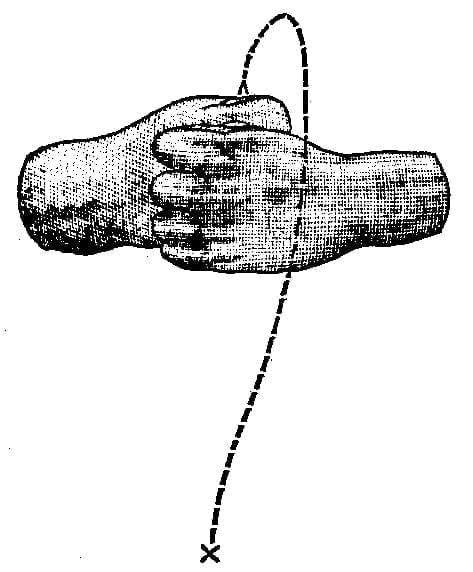
Clinch the right fist, and place it to the breast. (Absaroka I; Shoshoni and Banak I.)
Both hands fists, backs outward, obliquely upward, near together, right inside of left, are moved forward from in front of the chest, two or three times and back again to original position and then the right-hand fist is thrown with some force over the left on a curve. Endurance is expressed by this sign, and it is connected with the sun-dance trials of the young man in testing his bravery and powers of endurance before admission to the ranks of the warriors. (Dakota I.)
Push the two fists forward about a foot, at the height of the breast, the right about two inches behind the left, palms inward. (Dakota IV.) “The hands push all before them.”
Hold the left arm in front as if supporting a shield, and the right drawn back as if grasping a weapon. Close the fists, lower the head, moving it a little forward (with a “lunge”) as well as the arms and fists.. (Omaha I.) “I am brave.”
Another: Index and thumb extended parallel, palm to left, the other fingers bent. Shake the open fingers several times at the person referred to, the forearm being held at an angle of about 20°. (Omaha I.) “You are very brave; you do not fear death when you see the danger.”
Strike the breast gently with the palmar side of the right fist. (Wyandot I.)

Place the left clinched hand horizontally before the breast, palm toward the body, and at the same time strike forcibly downward in front of it with the right fist, as in Fig. 242. Sometimes the right fist is placed back of the left, then thrown over the latter toward the front and downward, as in Fig. 241 above. The same gesture has also been made by throwing the palmar side of the right fist edgewise downward in front of the knuckles of the left, as in Fig. 243. In each instance the left fist is jerked upward very perceptibly as the right one is thrust downward. (Kaiowa I; Comanche III; Apache II; Wichita II.)

Strike the clinched fist forcibly toward the ground in front of and near the breast. (Arikara I.)
– – He is the bravest of all.
Make the sign for Brave and then the left forefinger, upright, back inward about twelve inches in front of left breast, right index similarly held near the right breast, move them at the same time outward or forward, obliquely to the left, (Dakota I.)
Raise right hand, fingers extended, palm downward (W 1), swing it around “over all,” then point to the man, raise left fist (A 1, changed to left and palm inward) to a point in front of and near the body, close fingers of right hand and place the fist (A 2, palm inward) between left fist and body and then with violent movement throw it over left fist, as though breaking something, and stop at a point in front of and a little below left fist, and lastly point upward with right hand. (Sahaptin I.) “Of all here he is strongest.”
The right fist, palm downward, is struck against the breast several times, and the index is then quickly elevated before the face, pointing upward. (Apache I.)
Move the fist, thumb to the head, across the forehead from right to left, and cast it toward the earth over the left shoulder. (Apache III.)
Deaf-mute natural signs:
Run forward with a bold expression of the countenance. (Larson.)
Not to run back but to run forward. (Ziegler.)
Deaf-mute sign:
Left hand held as if pressing a loaf against the chest. Make a motion with the right hand, palm upward as if cutting through the fingers of the left with a sawing motion. (Wing.)
Other remarks connected with the signs for brave appear on pages 352, 353, and 358, supra.
